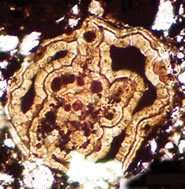Vernanimalcula
| Vernanimalcula Temporal range: 600–580 Ma | |
|---|---|
 | |
| The possible fossil of Vernanimalcula guizhouena | |
| Scientific classification | |
| Domain: | Eukaryota |
| Kingdom: | incertae sedis |
| (unranked): | Acritarcha |
| Genus: | Vernanimalcula |
| Species: | V. guizhouena |
| Binomial name | |
| Vernanimalcula guizhouena | |
| Part of a series on |
| The Cambrian explosion |
|---|
 |
|
Fossil localities |
|
Evolutionary concepts |
Vernanimalcula guizhouena is an acritarch dating from 600 to 580 million years ago; it was between 0.1 and 0.2 mm across (roughly the width of one or two human hairs). Vernanimalcula means "small spring animal", referring to its appearance in the fossil record at the end of the Marinoan Glaciation and the belief upon discovery it was an animal.

The Vernanimalcula fossils were discovered in the Doushantuo Formation in China. This formation is a Konservat-Lagerstätte, one of the rare places where soft body parts and very fine details are preserved in the fossil record. The Vernanimalcula fossils were interpreted as showing a triploblastic structure, a coelom, a differentiated gut, a mouth, an anus, and paired external pits that were believed possible sense organs, making it the earliest known member of the Bilateria (animals with bilateral symmetry, at least as embryos).
The appearance of Vernanimalcula so early in the fossil record was believed to have had important implications if it were really bilaterian. The radiation of animals into many phyla would have occurred before any animal became much larger than microscopic size, making the sudden appearance of many animal phyla in the Cambrian explosion an illusion[1] and merely represented a (geologically) sudden increase in size and the development of easily fossilised body parts by species in existing phyla.[2][3][4][5]
The description of Vernanimalcula as bilaterian has been strongly challenged. Other workers (Bengtson, Budd and co-workers) in the field have repeatedly claimed that Vernanimalcula is largely a taphonomic artefact generated by phosphate growth within a spherical object such as an acritarch, and thus Vernanimalcula was not even an animal, let alone a bilaterian.[6][7] Chen et al. initially defended their interpretation of Vernanimalcula against the claims of Bengtson and Budd.[8] Petryshyn et al. examined additional fossils resembling Vernanimalcula and concluded that the fossils are "likely biogenic in nature."[9]
See also
References
- ↑ Erwin, D. H.; Laflamme, M.; Tweedt, S. M.; Sperling, E. A.; Pisani, D.; Peterson, K. J. (2011). "The Cambrian Conundrum: Early Divergence and Later Ecological Success in the Early History of Animals". Science. 334 (6059): 1091–1097. doi:10.1126/science.1206375. PMID 22116879.
- ↑ Chen J. Y.; Bottjer D. J.; Oliveri P.; Dornbos S. Q.; Gao F.; Ruffins S.; Chi H.; Li C. W.; Davidson E. H.; et al. (2004). "Small bilaterian fossils from 40 to 55 million years before the cambrian". Science. 305: 218–22. doi:10.1126/science.1099213. PMID 15178752.
- ↑ Supporting Online Material from Science magazine. - accessed October 17, 2005
- ↑ Article on Vernanimalcula in Astrobiology Magazine - accessed October 15, 2005
- ↑ Article on Vernanimalcula in Scientific American - accessed October 15, 2005
- ↑ Bengtson, S.; Budd, G. (2004). "Comment on small bilaterian fossils from 40 to 55 million years before the Cambrian.". Science. 306 (5700): 1291a. doi:10.1126/science.1101338. PMID 15550644. Retrieved 2007-06-27.
- ↑ Bengtson, S.; Donoghue, P. C. J.; Cunningham, J. A.; Yin, C. (2012). "A merciful death for the 'earliest bilaterian,' Vernanimalcula,". Evolution & Development. 14: 421–427. doi:10.1111/j.1525-142X.2012.00562.x. PMID 22947315.
- ↑ Chen, Jun Yuan, Paola Oliveri, Eric Davidson and David J. Bottjer. 2004. Response to Comment on "Small Bilaterian Fossils from 40 to 55 Million Years Before the Cambrian". At - Retrieved June 20, 2007
- ↑ Petryshyn, Victoria A.; David J. Bottjer; Jun-Yuan Chen; Feng Gao (February 2013). "Petrographic analysis of new specimens of the putative microfossil Vernanimalcula guizhouena (Doushantuo Formation, South China)". Precambrian Research. 225: 58–66. doi:10.1016/j.precamres.2011.08.003. Retrieved 31 August 2013.